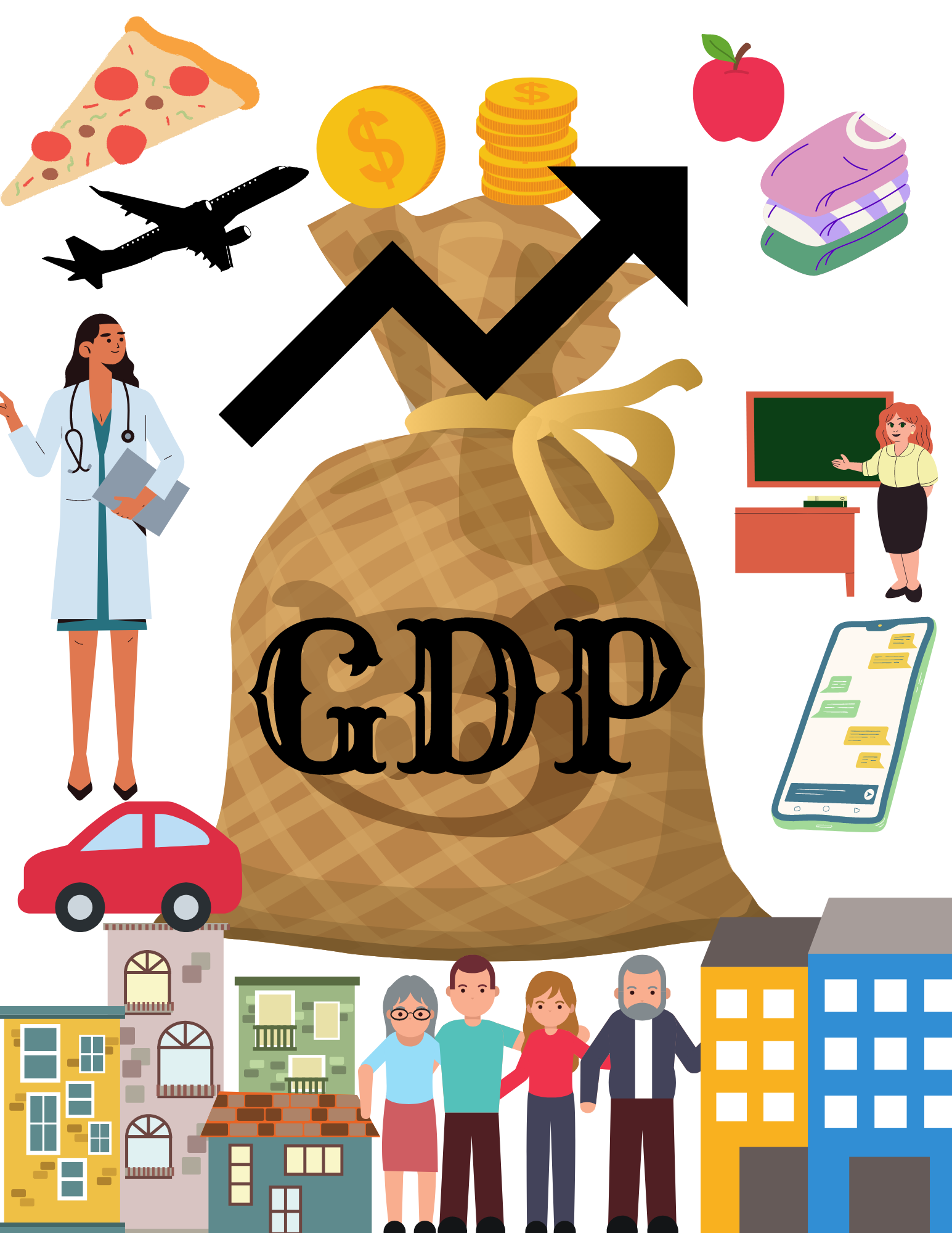The most widely used indicator for the overall health and size of an economy is its GDP statistics. Government and businesses use these statistics to see how our economy is doing. Usually, a higher GDP of a country indicates a higher standard of living for its people.
Even though it’s not a perfect measure of the happiness and there are some limitations of GDP, an increase in real GDP over time means the economy is growing overall.
Let’s start with understanding its literal meaning. GDP stands for gross domestic product. Here the word gross doesn’t mean bad, but it refers to total/aggregate, domestic means within the boundaries of a country and product includes the market value of all newly produced final goods and services.
By “goods” we mean any tangible product that we can touch, like food, clothing, cars, computers, phones, houses, and numerous other things, which businesses produce to sell for people to consume. So, if you are producing corn on your land but are not selling it to other people for money, it will not be counted in GDP.

Services, as the name suggests are non-tangible actions that provide us value. These range from a variety of services, such as those provided by a doctor, lawyer, internet provider, teacher, hairdresser, police officer, gardener, cleaner, and many more for which we pay them to be able to use it.
GDP is the total market value of newly-produced final goods and services produced within a country during a specific period, typically one year. In this definition, it is important to note that GDP will only include final goods and not intermediate goods such as raw materials used to produce that good or service. So, for example, if bread is bought by a consumer, it will be included in GDP. However, the same bread bought by a diner, which uses it as a raw material to make sandwiches, will not be counted in GDP. The reason is that the value of bread in the latter case is already included in the value of sandwich.
Also, any type of second-hand sale of a product is not included. The goods and services also have to produce within the country. If American cars are produced in China, they will not be included in the GDP of the US. Similarly, Japanese cars produced in America will be included in US GDP and not in Japan’s GDP.
Two important things to note here are the distinction between real vs nominal GDP and the population size of a country.
Real GDP or Nominal GDP: Which one should I care about?
Nominal GDP is calculated at nominal prices or current prices. Here, we sum the expenditure on all newly produced goods and services at the prices prevailing at that period when we calculate it. However, real GDP is GDP calculated at base-year or constant prices. If we see a higher nominal GDP number than last year’s, we need to examine what is the main reason behind the increase.
Since GDP is the market value of all final and newly-produced goods and services. Hence, the price and quantity of a product both will play roles in affecting the direction of GDP. A higher nominal GDP might simply be due to high prices without any change in the number of goods and services produced.
If we see prices rising over time, it will give us a higher nominal GDP number, even though the quantity of goods and services produced by a country hasn’t changed much.
For real growth to happen, the economy needs to be producing more goods and services. So, the real GDP is what matters, GDP that is adjusted for inflation.
Real GDP Per person is what matters for the standard of living
GDP can be higher if there are more people in a country, so more goods and services are needed to be produced. To measure the standard of living of people, we need to adjust for population size. When we divide real GDP by its total population, we get Real GDP per capita.
How do we calculate GDP?
There are 2 main ways of calculating it. These ways are the expenditure method and the income method.
Why do countries care about calculating GDP?
This calculation comes in handy when we want to compare different countries, and when we want to see how well a country is doing overtime. It is the most widely used indicator of economic growth.
So when we are looking at GDP numbers, we either look at them either in comparison to other countries or how the GDP over time is trending. I pulled data from the World Bank to show the trend of Real GDP in some of the world’s largest economies.

Another important factor to look at is the real GDP growth rate. GDP growth is the % change of GDP in a given year from GDP in the previous year. In the US, these calculations are done using the National Income and Product Accounts (NIPA) guidelines and published by the Bureau of Economic Analysis. Here is the chart showing US Real GDP over time. As of May 26, 2022, the US GDP is Q1 2022: 19,731.119 billion (chained dollars at 2012 prices).

During a period of rapid economic growth, the real GDP of a country usually grows at a rate of 7-8% or more per year. As the country reaches a developed or advanced economy status, GDP growth becomes more stable at 2-3% a year.
Many factors can contribute to continued GDP growth, including natural resources, capital, human capital, technological advancements, and good institutions. Countries that exhibit higher GDP growth, typically have all these factors contributing to it.


One response to “What is GDP? In the world of LOL, BRB, IDK, should I need to know another acronym?”
Very nicely explained